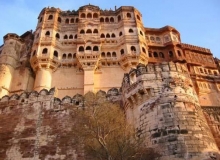
Speak to a specialist
0208 777 4873
0208 777 4873
Places to see: India

JODHPUR
Jodhpur is set at the edge of the Thar Desert. This imperial city echoes with tales of antiquity in the emptiness of the desert. In the past, it was the capital of the Marwar state, founded in 1459 A.D. by Rao Jodha - the chief of the Rathore clan of Rajputs. A high wall -10 km long with 8 gates and innumerable bastions encompasses the city. It was once a major trade center. Jodhpur is now the second largest city of Rajasthan.
Regarding the Jodhpur culture, the Jodhpuri people are amongst the most hospitable people of India. They have a typical Marwari accent. The lifestyle in Jodhpur, India is quite fascinating. The folks there wear nice and lovely multihued costumes. The women folk wear wide gathered skirts and a hip length jacket, with three quarter length sleeves, covering the front and back. Women are also love to wear jewelry on many parts of their body. Another one of the unique features of the culture of Jodhpur, Rajasthan is the colorful turbans worn by men. The popular tight, horse riding trousers, 'Jodhpurs', took their name from this city only. The main languages spoken here are Hindi, Marwari and Rajasthani.
The graceful palaces, forts and temples strewn throughout the city bring alive the historic grandeur of this city. Lending a romantic aura to Jodhpur, are its exquisite handicrafts, folk dances, folk music and the brightly attired people. The desert people are quite affable. With their sweet smiles and warm hospitality, they win the hearts of the tourists. The famous Marwar festival brings out the festive spirits of the people of this city. The bazaars of Jodhpur have a range of items from tie & dye textiles, embroidered leather shoes, lacquerware, antiques, carpets and puppets to the exquisite Rajasthani textiles, clay figurines, miniature camels and elephants, marble inlay work and classic silver jewellery.
Meherangarh Fort
Old City
Old City
Bishnoi Tribal Villages

JAISALMER
The Thar Desert
Forts
Havelis
Traditional Villages of Amarsagar
Forts
Havelis
Traditional Villages of Amarsagar

SAWAI MADHOPUR/ RANTHAMBORE
Tiger Reserve Ranthambhor National Park, once a princely game conserve is the scene where the celebrated Indian tigers are best seen. Ranthambhor Tiger Reserve lies on the junction of Aravali and Vindhyas just 14 Kms from Sawai Madhopur in Eastern Rajasthan. It sprawls over a varying and undulating landscape.
The tiger is not the only attraction at Ranthambhor; although it is the one park resident people come to see. We were lucky to see several varieties of birds including these owlets peering through their burrows pictured here on the right and of course the ubiquitous langur monkey. Other animals in the reserve include leopard, caracal, hyena, jackal, jungle cat, marsh crocodiles, wild boar, bears and various species of deer.
The main food source for the tiger is the swamp deer like Barasinsga and on occasion the wild buffalo and also wild boar.
Park Season: Opened During- 1st October to 30th June
Visiting Shifts- Morning and Afternoon trips
Closed During- 1st July to 30th September
The tiger is not the only attraction at Ranthambhor; although it is the one park resident people come to see. We were lucky to see several varieties of birds including these owlets peering through their burrows pictured here on the right and of course the ubiquitous langur monkey. Other animals in the reserve include leopard, caracal, hyena, jackal, jungle cat, marsh crocodiles, wild boar, bears and various species of deer.
The main food source for the tiger is the swamp deer like Barasinsga and on occasion the wild buffalo and also wild boar.
Park Season: Opened During- 1st October to 30th June
Visiting Shifts- Morning and Afternoon trips
Closed During- 1st July to 30th September

AMRITSAR
Amritsar, literally a Pool of Nectar, derives its name from Amrit Sarovar, the holy tank that surrounds the splendid Golden Temple. Guru Ramdas, the fourth Guru of the Sikh faith, founded Amritsar in 1579. He constructed a pool on land gifted by the Mughal Emperor Akbar and called it Amritsar.
Home to the world famous Golden Temple, the 400-year-old city of Amritsar is the most important seat of Sikh history and culture.
One of the most poignant memorials of free India -- Jallianwala Bagh – is also located in the city. Amritsar district was once a part of the vast area covered by the Indus valley Civilisation during the early period of history.
Home to the world famous Golden Temple, the 400-year-old city of Amritsar is the most important seat of Sikh history and culture.
One of the most poignant memorials of free India -- Jallianwala Bagh – is also located in the city. Amritsar district was once a part of the vast area covered by the Indus valley Civilisation during the early period of history.
Access:
The Rajasansi airport, about 11 km from city centre, is connected by domestic flights to Delhi, Srinagar and Chandigarh.
Amritsar is connected by rail with major cities in India.
Amritsar is connected by rail with major cities in India.
Sights to See
Golden Temple
Also known as Harmandir or Darbar Sahib, the temple is a white and gold majestic building, the foundation of which was laid by the Muslim saint, Mian Mir, an admirer and friend of Guru Arjun. The Mandir is built on a 67-ft square of marble and is a two storied structure. The top structure of the temple is covered with pure gold leaf, hence, the popular name, Golden Temple. Inside the temple lies the holy book of the Sikhs - the Granth Sahib.
More...
Durgiana Temple
A Durga Temple near the Golden temple founded by one of the greatest reformers and political leaders of resurgent India, Pandit Madan Mohan Malviya.
Akal Takht
Adjacent to the Golden Temple, Akal Takht, the supreme seat of Sikh religious authority was established by the sixth Sikh guru, Guru Hargobind (1606-1645). The Akal Takht also houses the ancient weapons used by the Sikh warriors.
Baba Atal Rai Tower
This octagonal, nine-storeyed tower located south of the Golden temple, represents the nine years of life of Atal Rai, son of the sixth Guru Hargobindji. The inner walls are decorated with frescoes on the life of Guru Nanak. The Adi Granth is enshrined within.
Central Sikh Musuem
The museum located atop the Tower of Baba Atal houses some fine old paintings of battles fought by the Sikhs, old manuscripts, coins and weapons.
Jallianwala Bagh
Among the most poignant memorials of free India is Amritsar's Jallianwala Bagh. On April 13, 1919, British General O'Dyer opened fire on a group of people attending a peaceful freedom movement meeting being held here.
Golden Temple
Also known as Harmandir or Darbar Sahib, the temple is a white and gold majestic building, the foundation of which was laid by the Muslim saint, Mian Mir, an admirer and friend of Guru Arjun. The Mandir is built on a 67-ft square of marble and is a two storied structure. The top structure of the temple is covered with pure gold leaf, hence, the popular name, Golden Temple. Inside the temple lies the holy book of the Sikhs - the Granth Sahib.
More...
Durgiana Temple
A Durga Temple near the Golden temple founded by one of the greatest reformers and political leaders of resurgent India, Pandit Madan Mohan Malviya.
Akal Takht
Adjacent to the Golden Temple, Akal Takht, the supreme seat of Sikh religious authority was established by the sixth Sikh guru, Guru Hargobind (1606-1645). The Akal Takht also houses the ancient weapons used by the Sikh warriors.
Baba Atal Rai Tower
This octagonal, nine-storeyed tower located south of the Golden temple, represents the nine years of life of Atal Rai, son of the sixth Guru Hargobindji. The inner walls are decorated with frescoes on the life of Guru Nanak. The Adi Granth is enshrined within.
Central Sikh Musuem
The museum located atop the Tower of Baba Atal houses some fine old paintings of battles fought by the Sikhs, old manuscripts, coins and weapons.
Jallianwala Bagh
Among the most poignant memorials of free India is Amritsar's Jallianwala Bagh. On April 13, 1919, British General O'Dyer opened fire on a group of people attending a peaceful freedom movement meeting being held here.
Customs
You should remain aware and respectful of the Sikh religion anywhere near the Golden Temple complex.
Inside the complex both men and women are required to cover their heads (scarves are widely available throughout the town for Rs 10, or a box of them are free to use at the entrances to the temple).
Smoking and alcohol are forbidden within the complex and anywhere within sight of the temple. Lighting up a cigarette on the busy street out front will definitely attract negative attention, as will spitting near the temple.
Photography is allowed on the outside ring of the holy lake, but not inside the actual temple itself.
Best time to visit Amritsar is in the winter, between October and March
Inside the complex both men and women are required to cover their heads (scarves are widely available throughout the town for Rs 10, or a box of them are free to use at the entrances to the temple).
Smoking and alcohol are forbidden within the complex and anywhere within sight of the temple. Lighting up a cigarette on the busy street out front will definitely attract negative attention, as will spitting near the temple.
Photography is allowed on the outside ring of the holy lake, but not inside the actual temple itself.
Best time to visit Amritsar is in the winter, between October and March
Subscribe here to our monthly newsletters


